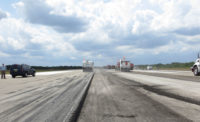A 354-ft-long, two-span steel bridge was lifted, rolled and set into construction history on March 26. With more than 1,000 spectators on hand, the nearly 4-million-lb structure traveled about 500 ft across Interstate 15 in Utah on a Self-Propelled Modular Transporter (SPMT), a vehicle-pulled platform supported by remote-controlled wheels and hydraulics. Eight hours later, the longest-ever SPMT-assisted bridge move in the Western Hemisphere was complete and ready for vehicular traffic.
Thirteen states have used SPMTs to roll pre-built bridge structures into place quickly, but the Utah Dept. of Transportation is the established leader. The March 26 move of the Sam White Bridge marks the 23rd time UDOT has used SPMTs.
Such fast-track accelerated bridge construction (ABC) techniques are what allow for the potential completion of the 24-mile, $1.725-billion Utah County Interstate 15 Corridor Expansion, also known as the I-15 CORE project, by December 2012, or in just three years.
Provo River Constructorsa design-build team led by Fluor Corp., Ames Construction Co., Wadsworth Brothers Construction Co. and Ralph L. Wadsworth Construction Co.won the contract through a fixed-price, best-design-scope concept. The concept allows us to fix the price and vary the scope, says Robert Stewart, UDOT project construction manager. The original goal was to expand 43 miles of I-15, but budget constraints curtailed that plan. We were able to go to industry and say, How much can you give us for this fixed price?' says Dal Hawks, UDOT project director.
PRC pledged not only to build 10 more miles than the minimum 14 but to do it two years ahead of the 2014 deadline, he adds. It won the $1.1-billion contract in December 2009. By the end of January 2010, all 125 design positions were occupied at the site office, says Brad Johnson, lead designer for HDR Inc., Omaha, the lead engineer and manager of overall design, which is just about complete.
The state-funded project will reconstruct 24 miles from Lehi to Spanish Fork in Utah, south of Salt Lake City, to meet transportation demands through the year 2030. Average daily traffic is as much as 140,000. In 2030, that same stretch will carry a projected ADT of 237,900, says Heather Barnum, a UDOT spokeswoman. The traffic count includes an estimated 22,000 trucks a day, some of which would get stuck underneath the old Sam White Bridge. The new bridge's underclearance will be 17 ft, 3 in., almost a 3-ft increase over the old bridge.
The Sam White Bridge move is the third of six to be moved by SPMTs on this project. The previous weekend, crews had a chance to practice for the record-breaking move, placing a two-span bridge with a total length of 325 ft.
The major SPMT provider in the U.S. historically has been the Dutch firm Mammoet. This time around, the team worked with the Belgian firm Sarens, a relative newcomer to the U.S., says Wayne Bowden, PRC manager of the section that includes the Sam White Bridge.
The technology keeps evolving in terms of blocking systems, monitoring and contingency, he notes of SPMTs. This system requires less personnel and not so many chains and containers. It had a clean monitoring system, with a set of lasers, a computer and TV monitors.
Crews began building the two Sam White spans east of the freeway. On the night of the move, I-15 was closed to traffic at 11 p.m. Two SPMTs moved beneath the two linked spans, lifted them up 21 ft and, with the help of temporary grading, began the two-hour, 500-ft trip down the highway toward the waiting abutments. Once there, the articulated SPMT tires allowed the structure to swivel about 90 for placement onto the abutments.



Post a comment to this article
Report Abusive Comment